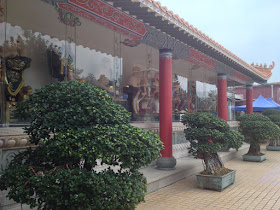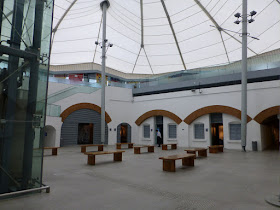Going off the beaten track isn't really that hard in Hong Kong. Actually, that's true for pretty much every city and country in existence. But what I mean here is that public transportation is so good that it's really not so hard to get anywhere in Hong Kong. So while most people don't head out to see the Ten Thousand Buddhas Monastery, it's easy to get to and worth the time.
Speaking of getting there, I had a bit of difficulty following Google Maps, mainly because the road mapping here (and actual roads themselves) is a bit sketchy. Sha Tin Station is the closest MTR station. At the gates, turn left, and head back to the pedestrian ramp seen above.This old building can be seen from that ramp; head down the ramp toward the square.
When I visited in 2014, the square was under construction, but that didn't affect pedestrian traffic much.
Head back towards the cluster of buildings with storefronts. you're going to head to the corner.
In the corner of this shopping area, there is a flower shop and a restaurant (those could change by the time you visit, but the buildings will probably remain). Head back in there to the path between the buildings.
Here is the path you want. Note the "stone" building on the left.
That path is mildly twisty; keep heading back. Note the pagoda way off in the distance. That isn't the monastery but can help guide you for a while.
Note the sign here leading the way. Follow the arrow to the left.
The path will continue for a little while. Just keep going. I believe there were tennis courts or something like that behind the dark green fence.
Eventually you'll reach some modern buildings. Again, keep going straight down that road. (Note: if you turn left here you'll end up at Po Fook Ancestral Hall with its own pagoda; admission there is supposedly free to and I've heard it's nice.)
The modern building is the Sha Tin Government Office. Head past its main entrance and keep going back.
And you'll eventually see this sign. That path will lead you to enlightenment. Or at least ten thousand Buddhas.
This isn't where the 10,000 Buddhas are. But your trip up the hill will take you past over 500 large Buddha statues, all in different poses. Note the white and red signs here. You should also see at least one sign warning against giving money to beggars who prey on the tourists. Note that the monastery is free and that the beggars are not part of the monastery; they might not even be Buddhists and beggars are not considered true believers. Save your donation money for the top and give it directly to the collection boxes.
Be sure to enjoy the Buddhas on your way up. If I'd had enough time I would have probably photographed each one to admire later. As it was, I probably shot about 50 pictures.
It's not an easy walk, especially if you're out of shape!
While the monastery is quite nice, as you'll soon see, I think I enjoyed the hike up more than the top.
Ahh! Stairs! My mortal enemy! These steps do mark the final battle in your march to the top.
The statues up here are a little bit different, too. If you pay enough attention, you'll notice the differences in statue detail and quality as you compare older and younger statues.
Finally, the top. This is the main building, inside which is the 10,000+ Buddha statuettes.
There are a few other structures, including a nine-story pagoda you can climb.
More interesting statues await you at the top.
This is Kwun Yam Pavilion.
Various statues and a collection box. I encourage you to donate to support the upkeep of all the fantastic statues.
The monastery was built fairly recently (finished in the 1950s) and the Buddhas were finished in the '60s. However, flooding and landslides damaged the area in 1997 and I believe it's now finally repaired.
The pagoda and the statues in the pavilion.
Looking out from the pagoda.
Behind the pagoda is another pavilion.
The main building, which houses around 13,000 mini Buddhas.
There are a couple large Buddhas inside.
Each of the 13,000 little guys are unique.
A staircase leads down to a small area. There are more statues here.
There are other things to be found further into the complex, but unfortunately my time was too short to fully explore. This is one of those places that I'd really like to visit again - both to see what I didn't have time for and to spend more time enjoying that which I've already experienced.
The monastery is open 9:00-5:30 every day, and admission is free. Plan to spend a good bit of time here, both for the journey up and down the hill and to take time to explore the grounds. And extra time for the Po Fook Ancestral Halls.












































































